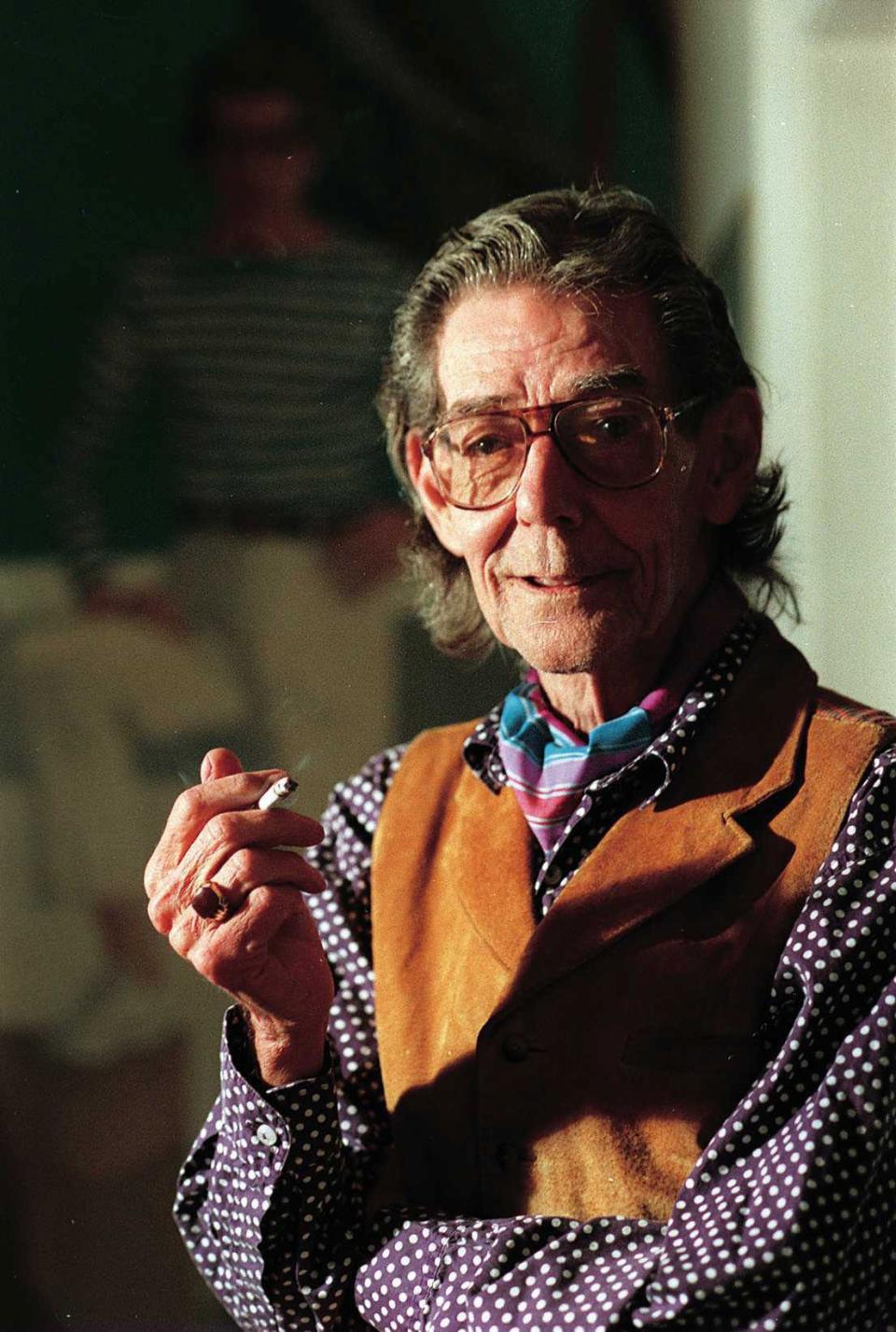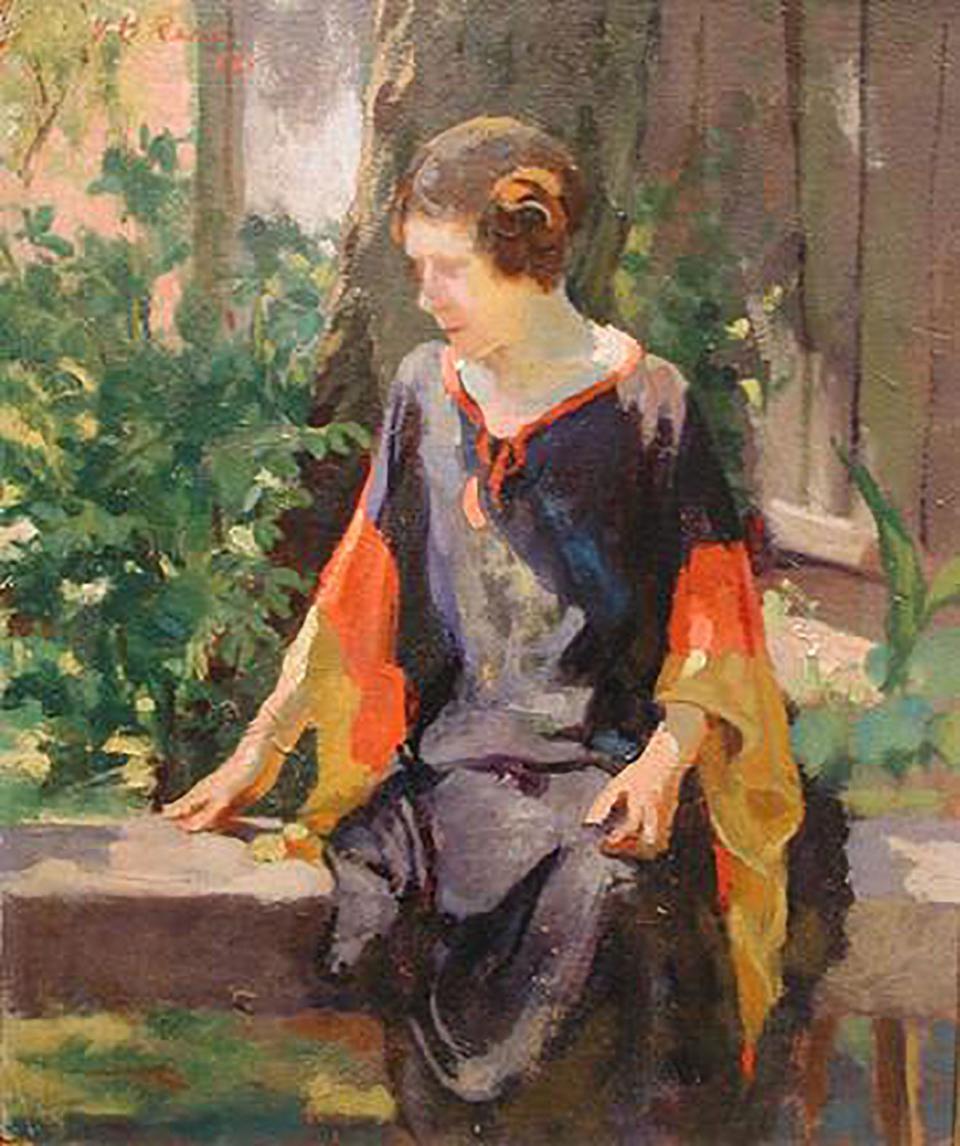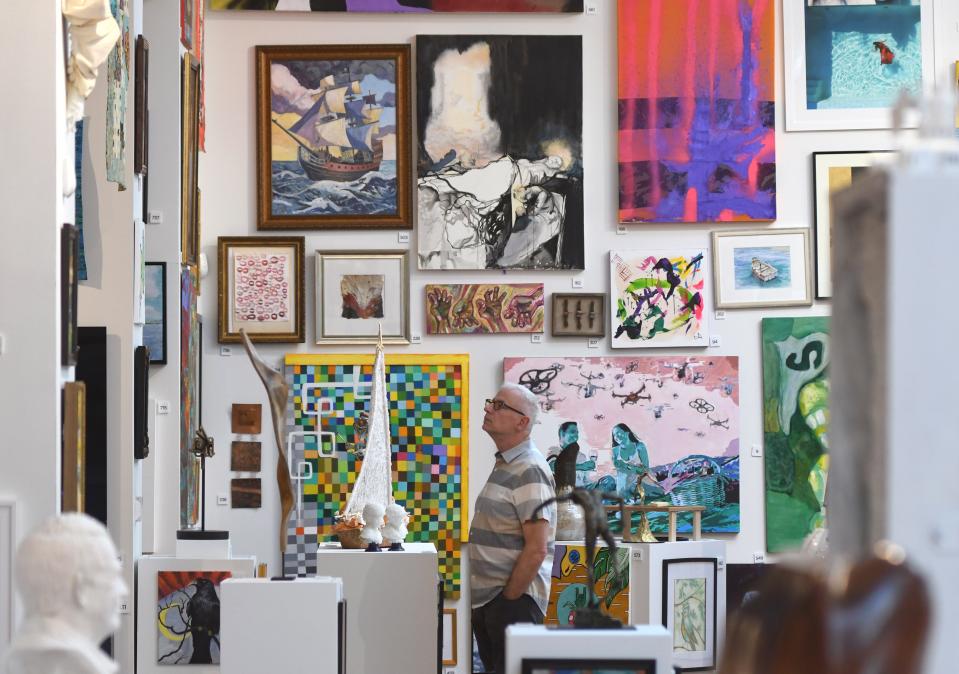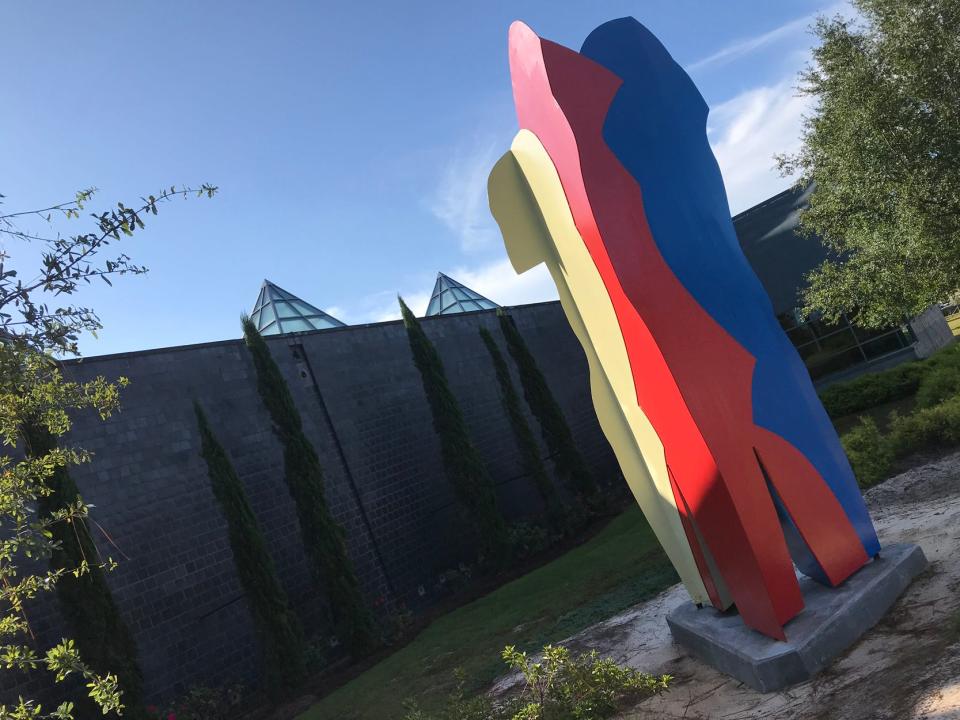How the Cameron Art Museum, 60 this year, grew into a vital Wilmington arts institution
- Oops!Something went wrong.Please try again later.
The first time Anne Brennan set foot in St. John's Art Gallery in downtown Wilmington, she was just 4 or 5 years old.
"I remember a little glass case with little perfume bottles made of different kinds of colored glass," Brennan said.
Brennan's mother, Irene, volunteered in the gift shop at St. John's. In 1990, Brennan would go to work at what was by then the accredited St. John's Museum of Art as a curator and registrar. In 2002, the museum would reopen in a new, 40,000-square-foot facility on South 17th Street as the Louise Wells Cameron Art Museum. Brennan has served as executive director since 2011.
Now, nearly six decades after her first interaction with it, Brennan is marking the 60th and the 20th anniversaries of a cultural institution that has become one of Wilmington's most vital.
"60+," a sprawling exhibition looking back at the museum's history and displaying work by some of the many artists in its collection, opened to the public at the Cameron on Friday. It runs through April 23, and on Nov. 12 the museum will host its 60th anniversary gala.
On Thursday, Brennan led a talk for 12 or 15 museum members, who got to see "60+" one day before it opened. Discussing the institution's earliest days as St. John's, which started in a historic Masonic lodge (North Carolina's oldest) on Orange Street built in 1804, Brennan said, her voice glowing, "It was nuts. I mean, how naive? To collect and take care of a permanent art collection in a building with no temperature control? It was a dangerous place even for humans to be."
From those rough beginnings, however, a Wilmington institution grew, something Brennan attributes to the collective and enduring efforts of staff, patrons, artists and, most importantly, the public.
"You're the 'plus' in '60+'," she said.
In "60+," you can see a re-creation of late Wilmington painter Claude Howell's lifelong home in the Carolina Apartments, complete with the artist's work, his personal journals and even some of his furniture. Brennan was a friend of Howell's and her voice filled with emotion when she talked about him and his dedication to the museum, which he thought enough of to leave $800,000 when he died in 1997, with the stipulation that it be used to acquire art by North Carolina artists.
"He wanted to put money into the pockets of the artists of this state," Brennan said. "To this day, we don't know where he got all that money."

The show also features work by another iconic Wilmington artist, the late Minnie Evans, who rose from being the gatekeeper at Airlie Gardens to having her work showcased in New York City art galleries.
And there's plenty more from the museum's vast collection of more than 3,300 pieces of art, including color etchings of American Impressionist Mary Cassatt − acquiring those in 1984 was "a game changer" for the museum, Brennan said − and prints from such modernist masters as David Hockney and Jasper Johns.
Similar to one of Minnie Evans' mandala-like works of art, Brennan loves the symmetry of it all: St. John's opened in April of 1962, and re-opened at the Cameron in April of 2002. Sixty years and 20 years.
Brennan attributes the institution's longevity not just to its collection, but to its ability to connect to and reflect the values of the Wilmington community and Southeastern North Carolina at large.
"We take the story of this region so seriously," Brennan said. "We exist for the community. There's not another museum like us in the state."
We could easily do 60 things to know about the Cameron Art Museum, its history and the people who have made it what it is today. For brevity's sake, however, here are six things to know about the museum, one for each decade it has enhanced the cultural life of Wilmington.
Its history predates the museum itself
For Brennan, the history of the Cameron Art Museum actually begins 100 years ago (another symmetry) in 1922, when the artist Elisabeth Chant moved to Wilmington. Setting up shop on Cottage Lane downtown, Chant taught art classes to Claude Howell, who would become one of Wilmington's most important artists, and to Bruce Barclay Cameron, who would become the museum's biggest benefactor.

Chant awakened the art scene in Wilmington, which by 1938 had its first proper museum, The Wilmington Museum of Art, on Princess Street. That museum closed in 1942 when government funding was re-directed to the World War II effort, but Wilmington's love for the arts remained.
After Chant's death in 1947, the Wilmington Art Association and others would hold annual shows on Cottage Lane, and by the late 1950s, artists Hester Donnelly and Virginia McQueen were looking for a new location for their closed gallery. With help from the Wilmington Art Association, they found it in that former Masonic Lodge on Orange Street, and an institution was born.
In 1964, Peggy Hall became St. John's first paid director (a part-time position), and the museum made its first art acquisition, an 1824 oil painting by Jacob Marling titled "Portrait of a Gentleman."
The museum is built on people, and relationships
"Institutions are people," Brennan said, and too many to mention have helped make the CAM what it is today.
Museum booster Sam Hughes "is the reason we have the collection we have," Brennan said. He helped the museum acquire those foundational Mary Cassatt prints in 1984 from Hughes' client, Therese Thorne McLane.
Hired in 1985, C. Reynolds "Ren" Brown would bring a new level of professionalism to the museum, and helped form the parameters of its central mission, which remains to this day: the acquisition and display of North Carolina art, as well as American art to help put the North Carolina works into context. Brown oversaw the transition from St. John's to the Cameron Art Museum, and served until his death in 2004.
Of course, the Cameron Art Museum would probably not exist without Wilmington's Cameron family and particularly the contributions of Bruce Barclay Cameron Jr. He donated $4.5 million for the construction of the museum (out of a total cost of $6 million), which was designed by acclaimed architect Charles Gwathmey, and Cameron's children donated the 9.5 acres of land where the museum and the Battle of Forks Road Civil War site are today.
Brennan said Cameron always said, "I don't know anything about art." But his wife, Louise Wells Cameron, who volunteered at St. John's for more than three decades and for whom the CAM is named, did. She died in 1997, and her husband help build the museum largely to honor her and her memory.
"If you were in a room with them you could feel the sparks, and they'd been married for decades," Brennan said.
Part of the museum's "60+" exhibit features Bruce Cameron's vast collection of intricately carved wooden duck decoys.
In 2017, the art collector Louis Belden donated his collection of over 100 works by modernist American masters, a major acquisition that will bolster the museum's collection for years to come.
The CAM has elevated marginalized voices
In 1970, Minnie Evans, a Black Wilmington artist with a fifth-grade education, had a exhibition of her vibrant, visionary work at St. John's Art Gallery. Five years later, she'd be showing at the Whitney Museum of American Art in New York City.
At least since then, if not before, the Cameron has sought out and highlighted the work of Black artists, women artists and others whose perspectives are often overlooked.
Elisabeth Chant's paintings were some of the first in the museum's collection, and the distinctly feminist Mary Cassatt's color etchings set the tone for future acquisitions.
When the Cameron Art Museum opened in 2002, its first exhibition featured the intricately carved gourds of Black North Carolina artist Michele Tejoula Turner.
In 2006, the museum's first annual living history weekend was held, with a focus on the U.S. Colored Troops who helped the Union win the final battle of the Civil War on the grounds where the museum is today.
Last year, a permanent sculpture by Durham artist Stephen Hayes, "Boundless," was unveiled in front of a large crowd to honor those troops.
Community is key
From its earliest days as St. John's, the museum has hosted lectures, musical performances, public art openings and more.
"Those activities remain 60 years later as part of our core," Brennan said.
Even during the pandemic, giant inflatable ducks were positioned outside the museum to give the public something fun to look at as they drove by.
The museum has a packed schedule of gallery talks, concerts, lectures, film screenings and, from time to time, theater or dance. Sometimes, they even invite members of the public to hang their art on the museum's walls.

In 2011, the CAM held its first "State of the Art/Art of the State" show, which allows any North Carolina resident to submit one piece of work. The show has been held every few years since, including this year, when more than 700 artists submitted work, proving so popular it spawned a "Kids State of the Art" show.
It hasn't always been smooth sailing
Just like any longstanding institution, the museum has faced, and met, its share of challenges over the years.
By 1970, the museum was struggling with space and funding. In response, museum booster Sam Hughes secured donations that allowed the museum to acquire two neighboring buildings: the historic Cowan House and the former St. Nicholas Greek Orthodox Church, which had moved to its current home on College Road. (The former St. John's Museum of Art complex is now the Wilmington Children's Museum.)
In the late '90s, a furor erupted when the museum announced a plan that would involve building a new facility on the site of the Hannah Block Historic USO/Community Arts Center. Patrons of the CAC, itself a beloved institution, rallied to its defense and the plan was scrapped.
When the museum announced it would be moving to its present location on 17th Street, which was much less developed two decades ago than it is today, critics decried it as a move to the middle of nowhere.
"Bruce (Cameron) said, 'The town will grow up around it,'" Brennan said. "And he was right."
After longtime director Ren Brown died in 2004, Deborah Velders of Houston's acclaimed Menil Collection was hired as director. Some, including at least one CAM board member at the time, felt that, under Velders, the museum had strayed from its community roots, programming exhibits that were perhaps more suited for a big-city museum than a small-town one.
Brennan is a staunch supporter of Velders and credits her with raising millions to help fund the museum's endowment; commissioning "genius grant" recipient Mel Chin's iconic sculpture on the museum grounds; and with installing beloved Wilmington sculptor Hiroshi Sueyoshi as the artist in residence at the museum's Pancoe education building in 2005. (Sueyoshi retired in 2014, but his large-scale sculpture "Harmony" was installed on the grounds in 2020.)

The pandemic is something Brennan said the museum is still recovering from. They had to lay off most of their staff at the time, but Heather Wilson was hired as deputy director in 2019 and the CAM appears to have largely bounced back, with packed houses for sculpture unveilings and exhibits, an often-full parking lot and a bustling vibe that's more community hub than staid gallery.
Education is the mission
"Education is our mission. It was in 1962, and it is today," Brennan said.
Hundreds if not thousands of schoolchildren visit the museum each year on field trips. Classes in the CAM's Museum School are held for artists of all ages. Kids at CAM is aimed at turning children on to the world of art, and the museum's summer art camps are full each year.
Brennan notes that the Wilmington Museum of Art, the Cameron's predecessor from the late 1930s and early '40s, also had a museum school.
She was glad to continue that tradition by starting the Cameron's Museum School in 2010. Today, Brennan has become more closely tied to the Cameron Art Museum than perhaps anyone in its history. But she knows it's bigger than her, even as she has helped it grow into what Wilmington needs it to be.
TIMELINE
1922: Elisabeth Chant moves to Wilmington, becomes important teacher and influence on artists including Claude Howell, helps organize area artists into an Art League.
1938: Ethel Williams and others open the Wilmington Museum of Art at 225 Princess St. Opening exhibit, "American Watercolors," featured works loaned from the Metropolitan Museum of Art in New York. Those active in forming the museum would be involved in starting St. John's Art Gallery more than 20 years later.
1942: With WPA funds now going to the World War II effort, Wilmington Museum of Art closes after 71 exhibits and more than 126,000 visitors in four years.
1940s and '50s: Annual art shows on Cottage Lane put on by Chant's former students keep the visual arts in the public eye.
1953: Wilmington Art Association forms, Claude Howell begins teaching art at Wilmington College, a forerunner of UNCW.
1957: After closing an art gallery in "post office alley" off Front Street, artists Hester Donnelly and Virginia McQueen seek a new facility for displaying works of art.
1962: With help from the Wilmington Art Association, St. John's Art Gallery opens in a historic 1804 building on Orange Street, the oldest Masonic Lodge in North Carolina. Formerly operating as St. John's Tavern, the building had been empty since 1955. First exhibit, which opens for the Azalea Festival, is a collection of paintings by Francis Speight.
1963: In its first two years, St. John's hosts 24 exhibits, as well as lectures and chamber music concerts.
1964: Peggy Hall hired as St. John's first director. It is a part-time position. The museum makes its first art acquisition, an 1824 oil painting by Jacob Marling titled "Portrait of a Gentleman."
1970: Iconic Wilmington artist Minnie Evans exhibits work at St. John's for the first time. Five years later, Evans would have a solo show at the Whitney Museum of American Art in New York.
1972: Caroline Milner becomes first full-time director.
1974: Changes name to St. John's Museum of Art; gains accreditation from American Alliance of Museums; expands in the neighboring Cowan House on Second Street and the former St. Nicholas Greek Orthodox Church, which moves to its current location on College Road.
1980: Alan Aiches becomes second full-time director.
1984: Sam Hughes convinces his friend and art collector Therese Thorne McLane to give the museum 13 color etchings from the 1890s by famed American impressionist Mary Cassatt.
1985: Ren Brown becomes third full-time director. Margie Worthington hired as curator of education.
1987: Museum renovated, celebrates with exhibit of work by Romare Bearden.
1990: Anne Brennan hired as registrar of collections.
1995: Museum exhibits work by famed glass sculptor Dale Chihuly. Major retrospective of Claude Howell's work to mark his 80th birthday.
1997: Claude Howell dies, leaving $800,000 to the museum for the acquisition of North Carolina art. Museum starts $6 million capital campaign to move to new facility, gets $4.5 million donation from Bruce Cameron and family, donation of 9.5 acres of land on current site.
2001: Ground broken for Cameron Art Museum, stained glass window by Rowan LeCompte donated by philanthropists Paul and Bunny Mellon.
2002: Louise Wells Cameron Art Museum opens on April 21. Building designed by architect Charles Gwathmey. First exhibition includes the work of Michele Tejuola Turner.
2003: Pancoe Art Education Center built with money donated by Beth and Walter Pancoe. Hiroshi Sueyoshi becomes artist in residence, serves until his retirement in 2014.
2004: Ren Brown dies after serving as director for nearly 20 years.
2005: Deborah Velders named museum director.
2006: First living history weekend to commemorate the Battle of Forks Road.
2007: Kids at CAM programs, summer art camps established.
2009: N.C. artist and "genius grant" recipient Mel Chin completes permanent outdoor sculpture "The Structure of Things Given and Held."
2010: Anne Brennan hired as assistant director, establishes Museum School.
2011: Anne Brennan hired as executive director.
2011: First "State of the Art/Art of the State" exhibit held.
2012: Actress and former Wilmington resident Linda Lavin donates private art collection to the museum.
2013: Bruce Cameron dies at age 95.
2014: Hiroshi Sueyoshi retrospective, "A Matter of Reverence"
2016: Annual "Illumination" exhibit of original lanterns and floating lantern ceremony held for the first time.
2017: Art collector Louis Belden leaves entire collection of 136 modernist prints, $1 million for the acquisition of new art.
2019: Heather Wilson named deputy director.
2020: Hiroshi Sueyoshi sculpture "Harmony" installed on museum grounds.
2021: "Boundless," Stephen Hayes' sculpture of U.S. Colored Troops, installed
2022: 60th anniversary exhibit "60+" opens, gala scheduled for Nov. 12.
SOURCE: Timeline info courtesy of Cameron Art Museum.
This article originally appeared on Wilmington StarNews: Cameron Art Museum celebrates 60 years in Wilmington NC

